Are you sure you want to leave 's MyShop site?
Are you sure you want to leave 's MyShop site?
Are you sure you want to leave 's MyShop site?
Are you sure you want to leave 's MyShop site?

Written by: David Vollmer, PhD, Chief Scientific Officer
Collagen is a vital protein your body makes naturally. Roughly 30% of your body’s protein is collagen and it makes up about 6% of your body weight. It can be found in your skin, hair, nails, connective tissues, bones, muscles, tendons, ligaments, cartilage, and even your intestinal lining.
The word collagen is derived from the Greek word “kolla,” meaning “glue,” and is considered the principal means of holding your body together. Collagen structure commonly presents itself as fibers, which are made up from three long, spiraling polypeptide chains. Each chain is composed of over 1000 amino acids—thought of as the building blocks of life.
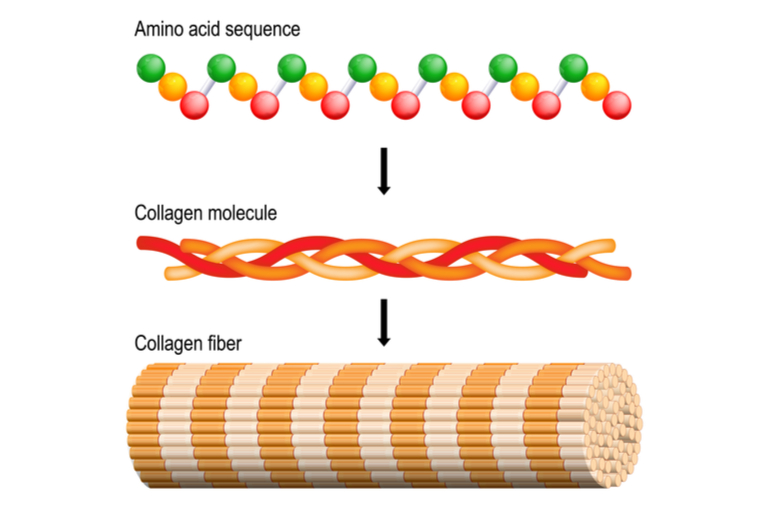
Much research has been done to understand what effects the collagen levels in your body. Factors that may affect levels are both intrinsic (things outside of your control) and extrinsic (things you can generally control). These factors have been shown to decrease collagen production and accelerate the breakdown of collagen.
The natural aging process can be considered an intrinsic factor. Throughout your life, there is a balance between collagen production (synthesis) and collagen breakdown (degradation). In your early years, collagen synthesis offsets degradation, whereas when you become older, that equilibrium tips in favor of degradation. For many people, collagen levels begin to decline as early as the third decade of life, and present as stiff, hardened fibers. The exact age when this occurs and its trajectory, however, can vary from person to person according to their genetics, as well as lifestyle choices.
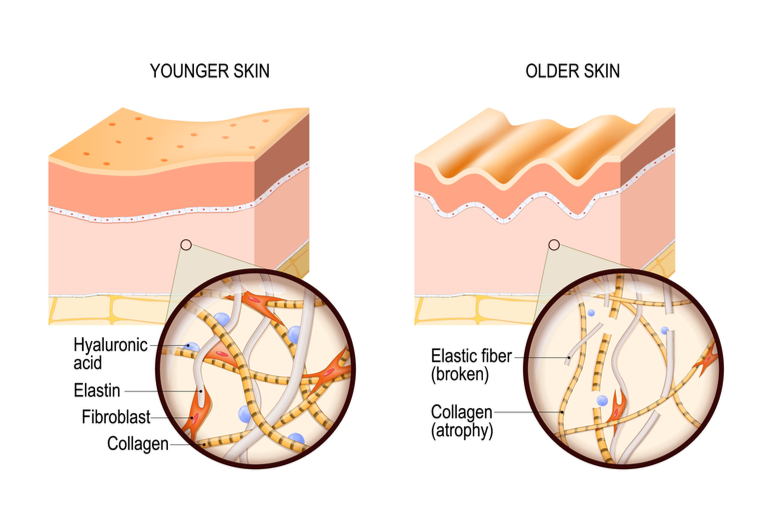
Environmental exposure is an example of an extrinsic factor, with sun exposure being considered one of the most harmful. Skin represents the primary target for UV radiation and can accelerate the aging process. Over exposure to UV rays causes free radicals to accumulate in skin cells and the extracellular matrix, which can lead to cell damage (a condition known as oxidative stress). Accumulated damage can prevent the normal functioning of underlying structures, such as collagen, and lead to changes in the skin’s appearance (e.g., fine lines and wrinkles).1
Poor nutritional choices are another extrinsic factor that impact collagen levels. Diets that are high in sugar, refined carbohydrates, alcohol, or processed meats can negatively activate the immune system and promote low-grade inflammation, which is detrimental to all body tissues. Sugar also promotes cross-linking of collagen fibers, making them less flexible and their natural repair process more difficult.
Scientists have identified at least 16 different types of collagen, with the most common forms being Types I, II, III, V and X. The primary differences in collagen types are attributed to three long polypeptide chains and how each is wound together. Each collagen type supports different functions of the body and often can come from varying sources. Type I collagen, for example, makes up 90% of the collagen in your body and is primarily found in your skin.

Collagen proteins are found in all living mammals. For dietary supplements, they are largely sourced from cows, pigs, chickens, and fish. When consumed in their natural form, collagen proteins are difficult to digest and distribute into your body.
A process called denaturation can improve the digestibility of proteins. This process involves the use of a denaturing agent, such as heat, chemical, or enzyme action, to weaken or break the bonds in protein molecules. The protein structure then changes shape, making it more accessible to the enzymes responsible for breaking the protein down into its component parts so that it can be digested (a process called hydrolysis).
The end-products are smaller sized short-chain amino acids, also called hydrolyzed collagen, and include high abundances of glycine, proline, and hydroxyproline. Hydrolyzed collagen is better absorbed and more efficiently transported throughout the body.

Collagen can come as different types and from varying sources, but which type is best for you, and what is the best source? As shown in the table below, the answer largely depends on your desired outcome. For those seeking support for skin, hair, nails, and muscles, Type I collagen is the best form.
To understand the best source of Type I collagen, we look to the scientific literature and our own research, both published and unpublished.2 In 4Life’s studies, the varying sources of Type I collagen have only subtle differences in terms of amino acid compositions and molecular size distribution. It is the plethora of independent, third-party publications of the skin, hair, and nails that truly differentiates the collagen source. While there are many studies from varying sources demonstrating the benefits of Type I collagen, a closer look at the literature suggests that marine-sourced (fish) collagen has more robust, supporting research than mammalian-sourced (cows, pigs, chickens) collagen.
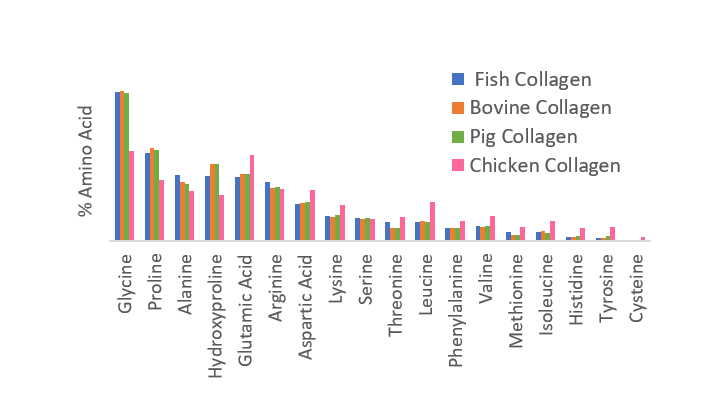
Preclinical experiments investigating the effects of collagen consumption suggest that it may stimulate synthesis and mitigate skin damage caused by UV radiation. Numerous clinical studies have been done to validate whether those effects could be translated into visual, age-related improvements, namely skin firmness and elasticity, fine lines and wrinkles, and skin tone.
In a double-blind, placebo-controlled study of 95 middle-aged women taking 2.5 g collagen per day, a significant improvement was observed in skin firmness after 8 weeks, perioral wrinkles (i. e., above the lips) after 12 weeks, and skin complexion homogeneity and radiance after 8 weeks.3 In a similar study of 60 mature women consuming 5 g of collagen per day, significant enhancements were seen in peri-orbital wrinkles (i. e., crow’s feet) after 8 weeks and facial skin fatigue after 4 weeks.4
Further studies demonstrate the benefits of Type I collagen towards hair, nail, and muscle/joint health. In a 16-week study of 44 healthy women, a significant increase was observed in the proliferation of hair follicles as well as hair thickness.5 A nine-month preclinical study also showed improved hair color, luster, and quantity.6 In an open-label clinical study with 24 participants taking 2.5 g of collagen, an increase in nail growth as well as a decrease in nail breakage was demonstrated.7 A double-blind, placebo-controlled study of 147 athletes taking 10 g of collagen per day for 24 weeks showed a reduction of joint discomfort when at rest, walking, standing, or exercising.8

Taking a hydrolyzed, marine-sourced, Type I collagen supplement can provide numerous benefits, including skin, hair, nail, and muscle/joint support.
Checkout 4Life Transfer Factor Collagen Type I: This product provides 5 g of Type l collagen, derived from fish sources, and other ingredients to help restore healthy collagen levels in the body, improve skin moisture and elasticity, support muscles, and provide antioxidant support. It also contains 4Life Transfer Factor Tri-Factor Formula to help your immune system recognize, respond to, and remember potential health threats.*
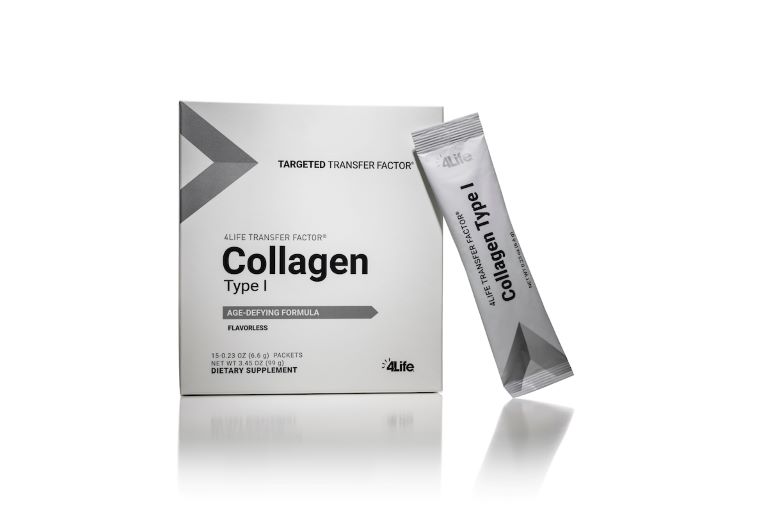
References** 1. Pugliese Physiology of the skin II. Allured Publishing Corporation; 2001. p. 109-137. 2. Vollmer, West, Lephart, Enhancing skin health: By oral administration of natural compounds and minerals with implications to the dermal microbiome. Int. J. Mol. Sci. 2018, 19, 3059. 3. Innovations in Food Technology, August 2017. 4. Duteil, Roussel, Bruno-Bonnet, Lacour Effect of Low Dose Type I Fish Collagen Peptides Combined or not with Silicon on Skin Aging Signs in Mature Women, JOJ Case Stud. 2018; 6(4): 555692. 5. Oesser The oral intake of specific Bioactive Collagen Peptides has a positive effect on hair thickness Nutrafoods (2020) 1:134-138. 6. Wang, Wang, Wang, Xu, He, Li, Ma (2017) Improvement of skin condition by oral administration of collagen hydrolysates in chronologically aged mice. J Sci Food Agric, 97(9), 2721-2726. 7. Hexsel, Zague, Schunck, Siega, Camozzato, Oesser, (2017) Oral supplementation with specific bioactive collagen peptides improves nail growth and reduces symptoms of brittle nails. J Cosmet Dermatol, 16(4), 520-526. 8. Clark, Sebastianelli, Flechsenhar, Aukermann, Meza, Millard, Albert 24-Week study on the use of collagen hydrolysate as a dietary supplement in athletes with activity-related joint pain. Curr Med Res Opin, 24(5), 1485-1496 2008.
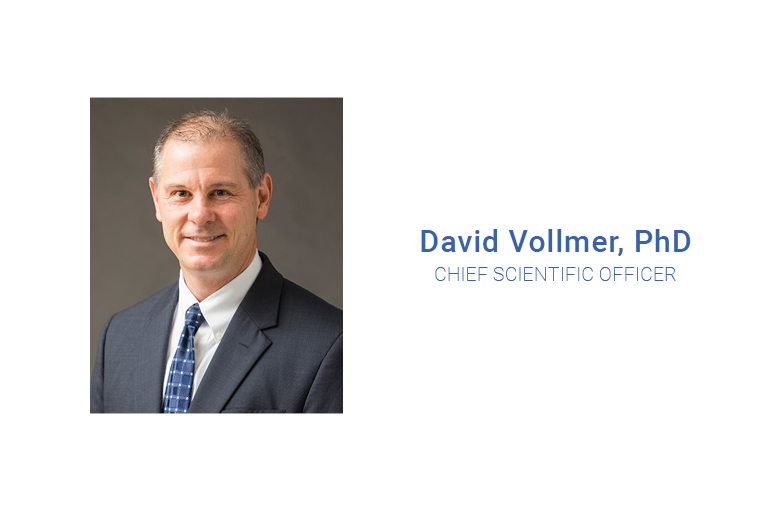
You are trying to view a MyShop page. Please log out in order to view this website.